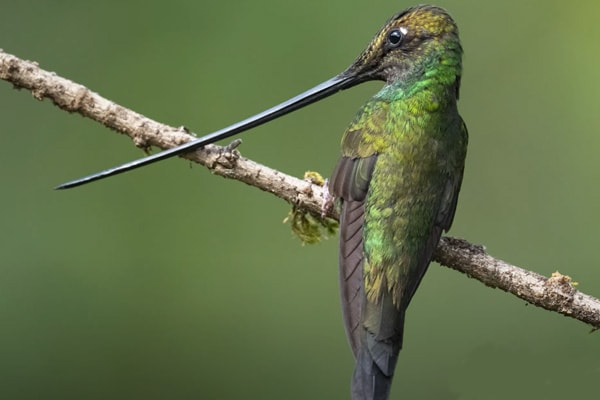Contents
- Sword-billed hummingbird bird facts
- How to identify a Sword-billed hummingbird
- Where You’ll See the Sword-billed hummingbird
- Diet and Feeding Preferences of the Sword-billed hummingbird
- Sword-billed hummingbird nesting
- Sword-billed hummingbird behavior
- Conservation Status of the Sword-billed hummingbird
- Fun & Interesting Facts About the Sword-billed hummingbird
- Explore More Species in This Family
The Sword-billed hummingbird also goes by the scientific name Ensifera ensifera. It is a remarkably popular hummingbird species with many distinctive features, including its longer body, its distinctively long bill, and the unique fact that it’s actually the largest hummingbird in the world.
Primarily, the Sword-billed hummingbird spends the bulk of its time in the Andean regions of South America. Breaking it down further, it lives in places like Bolivia, Peru, Venezuela, Ecuador, and Columbia. In these regions, this hummer loves to inhabit the beautiful cloud forests and montane forests found at higher elevations ranging anywhere from 5000-12,500 feet.
Here’s an interesting fact: the sword-billed hummingbird has an incredibly long bill, which actually creates some challenges for the fast-flying bird. When it comes to preening and grooming itself, the bill is so cumbersome that it often makes it difficult to accomplish these simple everyday tasks. It’s very difficult to perch on branches and maneuver as well because their bill is so long. To make up for this fact, the sword-billed Hummingbird is actually evolved in a way that it has specialized feet and strong leg muscles. These added much-needed stability for when it’s perching.
The sword-billed Hummingbird is considered a solitary nester, and it has many intriguing features and specialized adaptations. Although currently classified as Least Concern as far as conservation status goes, this hummingbird bird could face potential threats in the form of habitat loss because of agricultural activities, mining, and deforestation, so we have to be careful and continue to focus on high-value conservation efforts.
Right now, I want to tell you more about the nitty-gritty details of the Sword-billed hummingbird. The topics that I intend to cover in greater detail include:
- Physical descriptions and certain traits of sword-billed hummingbirds
- The differences between female and male sword-billed hummingbirds
- Dietary preferences, feeding choices, migration patterns, and nesting habits of sword-billed hummingbirds
- More detailed information about sword-billed hummingbirds
Would you love to learn more about sword-billed hummingbirds? Keep reading the information shared below to find out more about the largest hummingbird out of more than 300 hummingbird species.
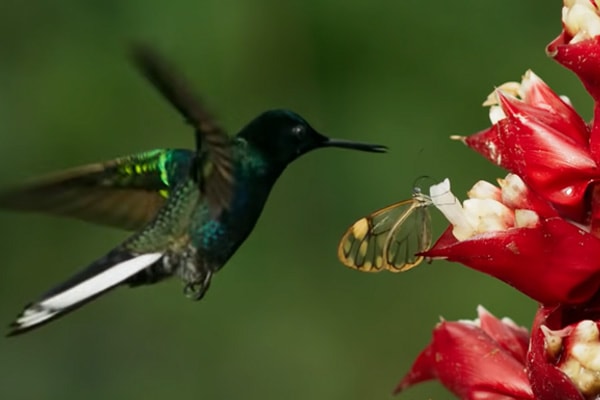
Sword-billed hummingbird bird facts
- Common Name: Sword-Billed Hummingbird
- Scientific Name: Ensifera ensifera
- Scientific Family: Trochilidae
- Life Span: 8-10 years
- Size: 5.1 to 5.9 inches
- Wingspan: 7.5 to 7.9 inches
- Weight: 0.40 to 0.50 oz
- Conservation status: Least Concern
How to identify a Sword-billed hummingbird
Identifying a sword-billed hummingbird is easier than you think because it definitely possesses a few distinguishing features. They include the following:
- Bill – the sword-billed hummingbird’s bill is its most prominent feature. Why? It’s incredibly long, thin, straight, and it has a slight curve at the tip. Believe it or not, it actually resembles a very slender sword, kind of like a thin scimitar.
- Size – the other interesting fact about sword-billed hummingbirds is out of all the Hummingbird species, it’s the longest and largest. On average, this Hummingbird it typically measures roughly 5.9 inches in length. A significant portion of their total length comes from their extra-long bill.
- Plumage – the sword-billed Hummingbird has typically dark plumage on the upper body, yet its body parts underneath are typically later in tone. Underneath, its feathers are often buff-colored on the chest or white. In the throat area, as well as the area surrounding the head, its feathers are an iridescent bronze or green color, which shimmers when it’s directly in contact with the sunlight.
- Tail – when compared to the rest of its body, the sword-billed hummingbird’s tail is rather short. It typically has dark colors, and it’s either slightly rounded or squared off at the tip.
Location and habitat also play an important role for the sword-billed Hummingbird. This bird tends to be found in certain habitats and locations, including cloud forests and montane forests in the Andean region of South America.
Difference between a male & female Sword-billed hummingbird
The differences between male and female sword-billed hummingbirds are mostly subtle. For starters, both male and female hummingbirds tend to have longer bills, but the males are typically a little bit longer than the female members of this bird species. But the difference is negligible at best.
Size is also a factor, but a negligible one. The male sword-billed Hummingbird is typically a little bit larger than his female counterpart as far as body length is concerned. But it isn’t a very significant length and it’s hardly noticeable unless making a direct comparison.
The plumage of male and female sword-billed hummingbirds is rather similar. Unlike most other hummingbirds, the iridescent throat patch is present on both male and female hummingbirds of the species, which isn’t usually the case amongst other hummingbirds.
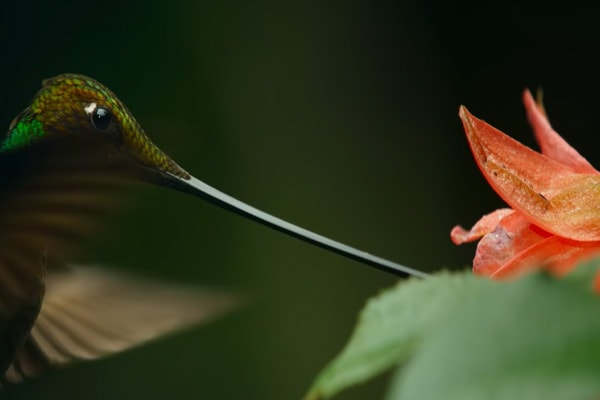
Differences in Summer Plumage vs Winter Plumage
Sword-billed hummingbirds do not experience any major or significant plumage changes between the winter and summer seasons. They mainly maintain consistent plumage all throughout the year.
Where You’ll See the Sword-billed hummingbird
Sword-billed hummingbirds love inhabiting high-altitude forested areas including cloud and montane forests. The elevations generally range anywhere from 5000-12,500 feet. These birds are specifically adapted to live in these types of habitats, which offer healthy supplies of nectar-rich flowers.
If you ever intend to visit these regions to check out the sword-billed hummingbirds in person, you should contact local bird watching clubs for guidance. This will increase your chances of observing this beautiful bird in its natural habitat.
The specific countries where you can find sword-billed hummingbirds include:
- Bolivia – there are certain parts of the Bolivian Andes that are inhabited by sword-billed hummingbirds. In particular, they seem to love the cloud forests near La Paz and they stick to the Yungas region as well.
- Columbia – these birds have a strong presence in the Colombian Andes. Their favorite locations in this mountain range seem to include the Central Andes and the Sierra Nevada de Santa Marta.
- Ecuador – it’s relatively common to spot sword-billed hummingbirds in parts of Ecuador. Primarily, they love spending time in the high-altitude regions of the Andes. Particularly, their favorite well-known habitats include Podocarpus National Park, Papallacta, and Mindo Cloud Forest to mention their favorite haunts.
- Peru – sword-billed hummingbirds love making the Peruvian Andes a major part of their territory and arrange. You can easily find these hummingbirds in places like Manu National Park, Machu Picchu, and Cordillera Blanca.
- Venezuela – these fast-flying hummingbirds also live in the mountainous regions of Venezuela. Particularly, they happen to really love the Andes Mountains.
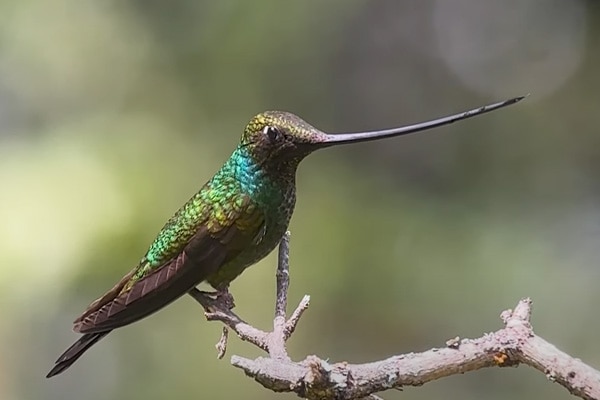
Sword-billed hummingbird migration patterns
The sword-billed Hummingbird practices a limited or restricted migration pattern. This means that it doesn’t undertake any long-distance seasonal migrations. It tends to stick within a certain range and has resident or sedentary populations. They really love living in cloud and montane forests all year long.
Within their local range, they will often exhibit short-distance altitudinal movements. These movements typically happen because it will become easier to find flowering plants at different elevations. They’ll move within their range more often than not because of resource availability.
As an example, at specific times of the year, you might find them moving to lower reservations because of abundant nectar sources or specific flowering cycles. These are relatively localized movements and aren’t necessarily looked upon as long-distance migrations.
Diet and Feeding Preferences of the Sword-billed hummingbird
This Hummingbird species enjoys consuming a specified diet that is made up of nectar as its primary source of sustenance. Diet and feeding preferences include the following:
- Nectar – the sword-billed hummingbirds’ main dietary component is nectar, which is true for many other hummingbirds as well. Their bills were adapted to gain access to nectar hidden within long tubular flowers. They can dig deep down within these flowers and gain access to the delicious nectar, which provides wonderful sustenance for these birds.
- Flower Preferences – sword-billed hummingbirds love getting nectar from some of their favorite flowers. Their favorite flowers of all tend to have long corollas, which is the tube-shaped part of the flower. It usually matches the full length of their bill. As far as specific flowers go, they tend to prefer Passiflora species, fuchsias, and bromeliads.
- Insects – sword-billed hummingbirds aren’t afraid to supplement their diet by consuming spiders and other small insects. They get extra protein and healthy nutrients from these reliable food sources. Typically, they’ll catch insects in mid-flight or snatch them off of their favorite vegetation.
- Water – sword-billed hummingbirds definitely need fresh water sources for bathing and drinking purposes. They tend to get their water from a number of sources, including streams, puddles, rainwater, and dew.
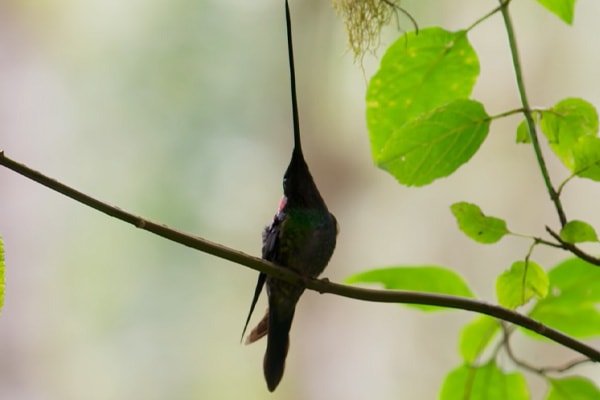
Sword-billed hummingbird nesting
- Clutch Size: 1-2 eggs
- # of Broods: 1 brood
- Incubation Period: 18-21 days
- Nestling period: 34-38 days
- Egg Description: White, Off-White
Sword-billed hummingbirds have very specific and interesting nesting behaviors that are quite unique to this species. As far as nesting construction is concerned, this responsibility falls on the shoulders of the female. She typically makes a cup-shaped nest from different plant materials including moss, lichen, and plant fiber. She will also use spiderwebs to help hold all of the nesting materials together because it provides excellent stability and strength.
While building her nest, she will do so relatively high up in a tree on high tree branches. The average height ranges anywhere from 10-65 feet above the ground. The female hummingbirds typically placed their nests in an area with lots of concealment including vertical cliff faces and dense foliage.
Sword-billed hummingbirds are considered solitary nesters. This means that they construct their own nests and maintain them as well. They will not nest within nest colonies and they do not participate in cooperative nesting behaviors.
The average clutch size for sword-billed hummingbirds is only one egg, but occasionally the female will lay a second egg. Incubation lasts approximately 18-21 days. The female will diligently set upon her eggs or eggs to keep them warm before hatching.
After the egg has hatched, the sword-billed hummingbirds take care of their nestlings together. The male and female will take turns feeding their nestlings by giving them small insects and regurgitated nectar. This will provide enough healthy nutrients for them to develop and grow.
The total nestling period lasts approximately 34-38 days. The young bird will remain within the nest throughout this time being cared for and fed by its parents until it’s time for it to fledge.
It’s possible that the sword-billed hummingbirds will reuse their old nest from another breeding season. If this is the case, they will typically make modifications or repairs to the old nest before laying a new egg clutch.
Sword-billed hummingbird behavior
The sword-billed Hummingbird exhibits very specific behaviors. I’ll touch on a number of their specific behaviors that haven’t been mentioned thus far. They include:
- Roosting Behavior – these hummingbirds are known to exhibit roosting behavior. They will seek shelter in places at night so they can rest and sleep. Often, they will choose protected branches covered with dense foliage for roosting, because it provides camouflage and safety.
- Interacting with humans – unlike many other hummingbirds, the sword-billed Hummingbird doesn’t particularly enjoy interacting with humans. They are wary of their presence and very shy. Nevertheless, they may tolerate human presence in ecotourism sites and let researchers and birdwatchers closely observe them.
- Altitudinal movements – for the most part, sort-billed hummingbirds are mostly cemetery and love staying at high altitudes. But certain changes and resource availability might cause them to shift to lower elevations in order to find abundant sources of nectar.
- Courtship Displays – the male members of this Hummingbird species will perform elaborate courtship displays in an effort to attract females. Their displays include diving, swooping, and making very distinct sounds while flapping their wings. These displays are designed to showcase their attractiveness, strength, and agility, which is definitely what a potential mate is looking for.
- Vocalizations – these birds are known to vocalize and an effort to communicate with one another. Within their vocal repertoire, they will use trills, whistles, and chirps. Males also make vocalizations during territorial disputes and courtship displays.
- Territorial Behaviors – these birds aren’t afraid to defend their territory from other hummingbirds. They want to keep their nesting sites and food sources safe from other competition. By guarding these areas fiercely, they keep them protected and guarantee that they’ll have a constant food supply whenever it’s needed.
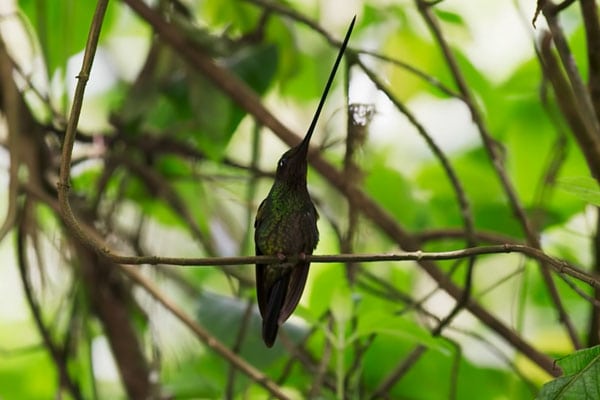
Conservation Status of the Sword-billed hummingbird
The conservation status of the Sword Billed Hummingbird is Least Concern. This means that this Hummingbird isn’t on the IUCN Red List of Threatened Species. In fact, the population isn’t in any immediate danger of survival and it’s relatively stable.
Fun & Interesting Facts About the Sword-billed hummingbird
- Sword-billed hummingbirds are expert hoverers. These birds can hover for extended periods in mid-air due to their rapid wing beats, which typically reach as many as 80 beats per second. They can maintain a stable position and feed on nectar while hovering in mid-air.
- The rapid beat of sword-billed Hummingbird wings produces a distinct humming sound. This is characteristic of many hummingbirds. They create this sound by beating their wings at such high speeds that it makes a noise when the air rushes over them.
- They also possess a unique perching adaptation. Their bills are extraordinarily long, so they had to adapt their perching behavior because of them. They will place their bills in an upright position while perched, even leaning their heads back to properly balance out the extra weight.
- Slow reproduction is definitely part of the sword-billed hummingbird’s existence. When compared to other hummingbirds, the female is only known to typically lay one egg per clutch and she’ll only lay one clutch per year. Many other hummingbirds will lay 2-3 eggs per clutch and often lay multiple clutches per year.
- They are particularly adept at using their long bill to make the most of unique feeding opportunities. Their bill is so long, which gives them access to nectar in long tubular flowers. This nectar is often impossible for other Hummingbird species to reach. This special adaptation is unique to sort-billed hummingbirds.
Explore More Species in This Family
- Green Thorntail (Discosura conversii)
- Plain-capped Starthroat (Heliomaster constantii)
- Buff-bellied Hummingbird (Amazilia yucatanensis)
- Black-chinned Hummingbird (Archilochus alexandri)
- Gorgeted Woodstar (Chaetocercus heliodor)
- Booted Racket-tail (Ocreatus underwoodii)
- Ruby-throated Hummingbird (Archilochus colubris)
- Magnificent Hummingbird (Eugenes fulgens)
- Little Woodstar (Chaetocercus bombus)
- Rufous Hummingbird (Selasphorus rufus)
- Bronze-tailed Plumeleteer (Chalybura urochrysia)
- Cinnamon Hummingbird (Amazilia rutila)
- Fiery-throated Hummingbird (Panterpe insignis)
- White-tailed Goldenthroat (Polytmus guainumbi)
- Shining Sunbeam (Aglaeactis cupripennis)
- White-vented Plumeleteer (Chalybura buffonii)
- Allen’s Hummingbird (Selasphorus sasin)
- Amethyst Woodstar (Calliphlox amethystina)
- Calliope Hummingbird (Selasphorus calliope)
- White-bellied Woodstar (Chaetocercus mulsant)
- Green-breasted Mango (Anthracothorax prevostii)
- Berylline Hummingbird (Amazilia beryllina)
- Brazilian Ruby (Clytolaema rubricauda)
- Long-tailed Hummingbird (Rhamphomicron longicauda)
- Sparkling Violetear (Colibri coruscans)
- Violet-headed Hummingbird (Klais guimeti)
- Ecuadorian Hillstar (Oreotrochilus chimborazo)
- White-necked Jacobin (Florisuga mellivora)
- Black-breasted Puffleg (Eriocnemis nigrivestis)
- Red-billed Streamertail (Trochilus polytmus)
- Crowned Woodnymph (Thalurania colombica)
- Black-throated Mango (Anthracothorax nigricollis)
- Violet-crowned Hummingbird (Amazilia violiceps)
- Purple-crowned Fairy (Heliothryx barroti)
- Xantus’s Hummingbird (Hylocharis xantusii)
- Blue-throated Hummingbird (Lampornis clemenciae)
- Ruby-topaz Hummingbird (Chrysolampis mosquitus)
- Violet Sabrewing (Campylopterus hemileucurus)
- Long-tailed Sylph (Aglaiocercus kingii)
- Snowcap (Microchera albocoronata)
- Black-crested Coquette (Lophornis helenae)
- Anna’s Hummingbird (Calypte anna)
- Broad-tailed Hummingbird (Selasphorus platycercus)
- Costa’s Hummingbird (Calypte costae)
- Long-billed Hermit (Phaethornis longirostris)

